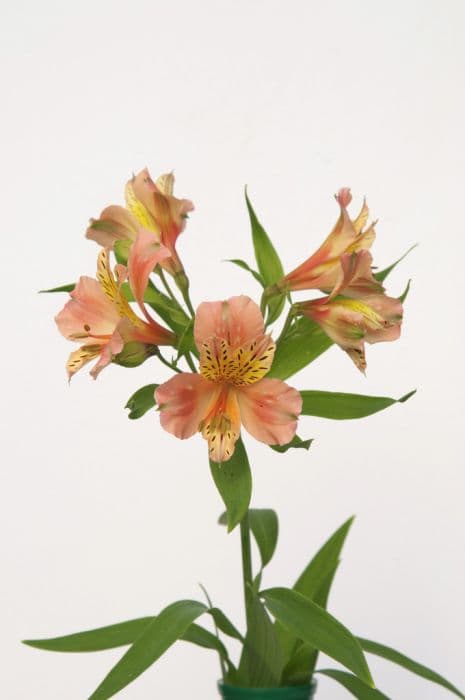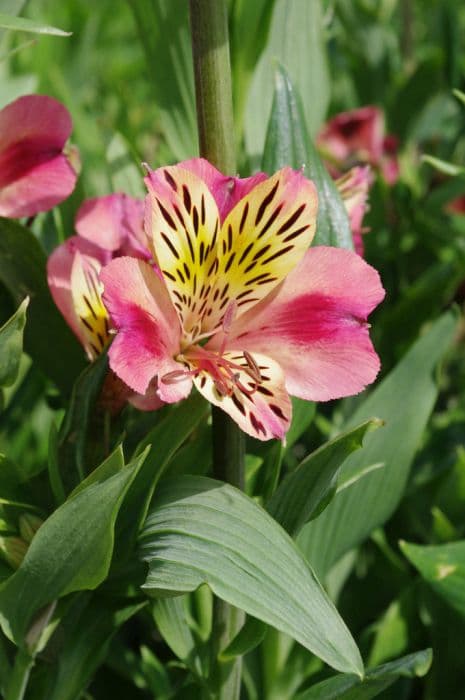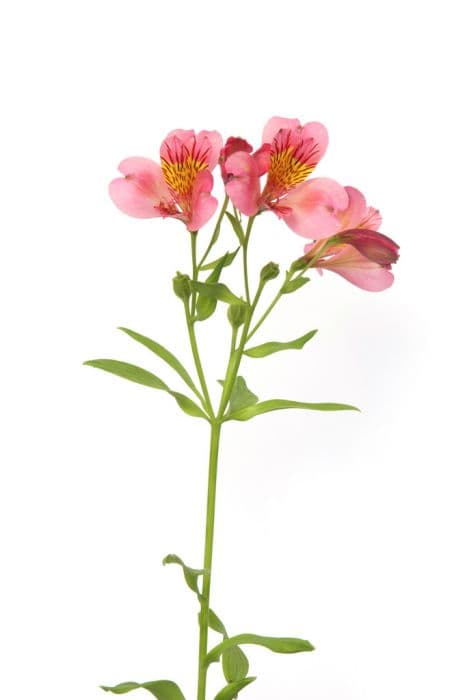Peruvian lily 'Sweet Laura' Alstroemeria 'Sweet Laura' (PBR)

ABOUT
'Sweet Laura' is a herbaceous perennial, up to 85cm high, with lance-shaped leaves and faintly-scented flowers, from summer to autumn, rich yellow flecked with brown and tipped with orange
About this plant
 Names
NamesSynonyms
Peruvian Lily, Lily of the Incas, Parrot Lily
Common names
Alstroemeria 'Sweet Laura' (PBR).
 Characteristics
CharacteristicsLife cycle
Perennials
Foliage type
Deciduous
Color of leaves
Green
Flower color
Mixed
Height
2-3 feet (60-90 cm)
Spread
1-2 feet (30-60 cm)
Plant type
Herb
Hardiness zones
7
Native area
South America
Benefits
 General Benefits
General Benefits- Attracts Pollinators: It is attractive to bees, butterflies, and other beneficial insects, which are important for pollination in the garden.
- Long Blooming Period: This variety often has a lengthy bloom time, which can extend from late spring through to the fall, providing extended color and interest in the garden.
- Excellent Cut Flowers: The blooms of Alstroemeria, also known as the Peruvian Lily, are known for their exceptional vase life, often lasting two weeks or more.
- Drought Tolerance: Once established, the Peruvian Lily is moderately drought tolerant, making it suitable for regions with drier climates or for gardeners seeking water-wise plants.
- Versatile Planting Options: Alstroemeria 'Sweet Laura' can be grown in containers or borders, offering flexibility in garden design and use of space.
- Hardy Nature: It is generally hardy and can withstand a range of soil types and garden conditions, which makes it a robust addition to the garden.
- Vibrant Colors: The bright yellow and orangish-red flowers bring a vibrant splash of color to gardens and landscapes, uplifting the aesthetics of outdoor spaces.
- Non-Invasive: Unlike some other Alstroemeria varieties, 'Sweet Laura' is bred to be less aggressive in spreading, minimizing the risk of it overtaking other plants in the garden.
 Medical Properties
Medical PropertiesThis plant is not used for medical purposes.
 Air-purifying Qualities
Air-purifying QualitiesThis plant is not specifically known for air purifying qualities.
 Other Uses
Other Uses- Alstroemeria 'Sweet Laura', commonly known as Peruvian Lily, can be used as a natural dye for fabrics and paper due to the pigments present in its petals.
- Peruvian Lily petals can be pressed and incorporated into candles for decorative purposes, adding a unique floral touch to homemade candles.
- These flowers can also serve as a source of inspiration for artists and designers, who might use them as subjects or motifs in paintings, textiles, and patterns.
- Peruvian Lily foliage can be used in terrariums or miniature landscapes, providing lush greenery alongside other small plants.
- The stems of the Peruvian Lily can be used in basketry as a weaving material when dried, offering a unique texture and color.
- Dried Peruvian Lily flowers can be used in potpourri mixes, contributing their shape and possibly a faint scent to a room's ambiance.
- The vibrant colors of the Peruvian Lily can be used in photography, as a natural contrasting background or foreground subject for macro photography.
- Edible parts of Peruvian Lily, such as its tubers, can be used in culinary arts, offering an unexpected flourish to food presentations (only with non-toxic varieties).
- Due to its structural beauty, Peruvian Lily can be used in educational settings for botanical studies and flower dissection activities.
- Finally, Peruvian Lily can be used as a natural confetti. Its petals can be tossed at celebrations, creating a biodegradable alternative to traditional paper confetti.
Interesting Facts
 Feng Shui
Feng ShuiThe Peruvian Lily is not used in Feng Shui practice.
 Zodiac Sign Compitability
Zodiac Sign CompitabilityThe Peruvian Lily is not used in astrology practice.
 Plant Symbolism
Plant Symbolism- Devotion and Friendship: Alstroemeria, also known as the Peruvian Lily, is often associated with strong bonds of friendship and the enduring nature of devotion, representing the interconnectedness and mutual support found in close friendships.
- Wealth, Prosperity, and Fortune: Because of its vibrant blooms and long-lasting, Alstroemeria is sometimes given as a gesture wishing someone prosperity and good fortune in their lives.
- Achievement of Aspirations: The flower's growth habit and the way it reaches for the sun is symbolic of striving towards goals and the determination to achieve one's aspirations.
- Mutual Support: The complex, twisted leaves of Alstroemeria symbolize the ups and downs of relationships while suggesting the intertwining of two lives that support each other through life's challenges.
 Water
WaterFor the Peruvian Lily, which is the common name for Alstroemeria 'Sweet Laura', regular watering is essential to keep the soil consistently moist but not waterlogged. During the growing season, water thoroughly once a week with approximately one gallon of water per plant. In hotter temperatures or if the plant is in a container that dries out faster, check the soil moisture more frequently and water as needed to maintain moisture. Reduce watering in the winter months when the plant is not actively growing. Avoid overhead watering to prevent disease; instead, water at the base of the plant.
 Light
LightPeruvian Lilies thrive best in full sun to partial shade. A location that receives morning sunlight and partial afternoon shade is ideal to protect the flowers from intense, midday heat which can be detrimental. East or west-facing spots that provide at least 6 hours of sunlight are excellent choices for these plants.
 Temperature
TemperaturePeruvian Lilies, such as Alstroemeria 'Sweet Laura', prefer temperatures between 65 to 80 degrees Fahrenheit during the day and should not be exposed to temperatures below 29 degrees Fahrenheit as they can be damaged by frost. Ideal nighttime temperatures range from 40 to 50 degrees Fahrenheit. While they can survive brief periods of higher or lower temperatures, consistently staying within this range is optimal for their growth.
 Pruning
PruningPeruvian Lilies should be pruned to encourage vigorous growth and more blooms. Deadhead spent flowers regularly to promote continuous flowering. After the blooming season, cut back the stems to ground level to encourage the plant to store energy for the next season. The best time for this heavier pruning is in late autumn or early winter after the first frost has passed.
 Cleaning
CleaningAs needed
 Soil
SoilPeruvian Lily 'Sweet Laura' prefers well-draining, fertile soil with a pH of around 6.5. A good mix would be part loamy soil, part peat, and part sharp sand or perlite to ensure proper drainage. Regularly organic matter can be added to keep the soil fertile.
 Repotting
RepottingPeruvian Lilies should be repotted every two to three years or when the clumps become overcrowded. Transplant 'Sweet Laura' during spring or early summer for best results.
 Humidity & Misting
Humidity & MistingPeruvian Lily 'Sweet Laura' thrives in moderate humidity levels. Aim for around 40-60% relative humidity for optimal growth. Avoid excessively dry or damp air.
 Suitable locations
Suitable locationsIndoor
Place 'Sweet Laura' in bright, indirect light and ensure the pot drains.
Outdoor
Plant in partial shade, shelter from strong winds, and well-drained soil.
Hardiness zone
5-9 USDA
 Life cycle
Life cycleAlstroemeria 'Sweet Laura', commonly known as Peruvian Lily or Lily of the Incas, begins its life cycle when seeds germinate, typically in spring, requiring warmth and moisture. The seedlings develop into young plants with characteristic lance-shaped leaves, and as they mature, rhizomatous roots form which help the plant establish itself firmly in the soil. During the growing season, usually from late spring to early summer, the Peruvian Lily produces stems that bear clusters of striking, funnel-shaped flowers in shades of yellow and orange, marked with characteristic streaks and spots. After blooming, which can last several weeks, the plant enters a period of dormancy, especially in regions with colder winters, retreating to its rhizomes to conserve energy. In the following growing season, it emerges again, often producing new shoots from the rhizomes, and perpetuating its growth cycle. With adequate care, Alstroemeria 'Sweet Laura' can continue this cycle for several years, spreading slowly through its rhizomes to form larger clumps.
 Propogation
PropogationPropogation time
Spring-Early Summer
The most popular method of propagation for Alstroemeria 'Sweet Laura', commonly known as the Peruvian Lily or Lily of the Incas, is by division of its tuberous rhizomes. This is typically done in the spring or early summer when the plant has finished blooming and is entering its dormant phase. Gardeners should carefully dig up the clumps, trying not to damage the roots, and then gently separate the rhizomes by hand, ensuring that each division has at least one growth point or eye. These divisions can then be immediately replanted in well-draining soil at a depth of about 6 to 8 inches (15 to 20 centimeters), spaced approximately 12 to 18 inches (30 to 45 centimeters) apart to allow for adequate growth. Adequate watering and light fertilization will help establish the new plants. This approach encourages the healthiest growth and maintains the vigor of the cultivar.




![Peruvian lily [Indian summer]](/_next/image?url=https%3A%2F%2Fplants-admin.emdemapps.com%2Fimages%2Fplants%2F%2Fimages%2F604b616bc746b.png&w=640&q=75)
![Peruvian lily [Inticancha Creamy Dark Pink]](/_next/image?url=https%3A%2F%2Fplants-admin.emdemapps.com%2Fimages%2Fplants%2F%2Fimages%2F604b5e98bea7c.png&w=640&q=75)
![Peruvian lily [Inticancha Imala]](/_next/image?url=https%3A%2F%2Fplants-admin.emdemapps.com%2Fimages%2Fplants%2F%2Fimages%2F604b619b522ba.png&w=640&q=75)
![Peruvian lily [Inticancha Red]](/_next/image?url=https%3A%2F%2Fplants-admin.emdemapps.com%2Fimages%2Fplants%2F%2Fimages%2F604b5aebac273.png&w=640&q=75)
![Peruvian lily [Inticancha Sunday]](/_next/image?url=https%3A%2F%2Fplants-admin.emdemapps.com%2Fimages%2Fplants%2F%2Fimages%2F604b646146dd9.png&w=640&q=75)
